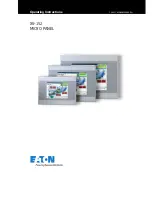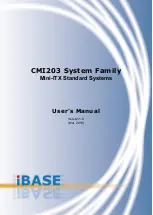
English (GB)
36
10. Detailed descriptions of registers
10.1 Separation of reads and writes
This functional profile supports Modbus holding registers, which
means that registers can be both read and written. By default,
most of the register values meant for writing by the Modbus
master is also updated by the CIU unit itself to reflect the actual
value used by CIU.
Differences arise due to internal value limitations and because
some settings and control values can have other sources, for
example service port and display that can change the actual
values. To avoid such conflicts, the profile has the option of read
and write separation with the option Config.ReadWriteSeparation
(register 00006, bit 1 = 1). Using this option means that all writing
registers [W] use an associated reading location [R] where the
resulting status of the writing always can be verified. In this case,
reading and writing never takes place via the same registers,
Alarm simulation registers being the only exceptions. Reading a
writing register only means reading what has previously been
written to the Modbus interface, and in the general case this will
not reflect what value the CIU unit is actually using.
Example 1
Setting and reading overflow level with ReadWriteSeparation
disabled [default].
The user writes a new value to SinglePitStopLevel
(register00102).
The resulting overflow level is then read from SinglePitStopLevel
(register 00102).
Example 2
Setting and reading overflow level with ReadWriteSeparation
enabled.
The user writes a new value to SinglePitStopLevel (register
00102).
The resulting overflow level is then read from SinglePitStopLevel
(register 00204), hence separating reads from writes.
10.2 Control bit acknowledgement
All control bits in the functional profile are triggered on the rising
edge of a bit. The system supports two different approaches to
control bit acknowledgement: Auto and manual.
The AutoAckControlBits setting (register 00005) sets the desired
approach:
0: Disabled.
Control bits are not automatically lowered when accepted by the
device. The user must lower the control bit manually before the
control bit can be triggered again. When a control bit is accepted
by the device, the corresponding control bit acknowledgement is
raised, and the user can lower the control bit.
1: Enabled.
Control bits are automatically lowered when accepted by the
device, so the user does not have to lower it manually [default].
Example 1
ResetAlarm with auto-acknowledgement enabled [default].
The user sets the PitControl.ResetAlarm control bit (register
00101, bit 0) to 1 to reset an alarm. When accepted by the slave,
the PitControl.ResetAlarm control bit is automatically reset to 0.
The user can then set the PitControl.ResetAlarm control bit to 1
again to reset an alarm again.
Example 2
ResetAlarm with auto-acknowledgement disabled.
The user sets the PitControl.ResetAlarm control bit (register
00101, bit 0) to 1 to reset an alarm. When accepted by the slave,
the AcknowledgeRegister.ResetAlarmAck (register 00201, bit 0)
is set to 1, and the PitControl.ResetAlarm is still 1. The user must
then manually set PitControl.ResetAlarm to 0 before another
alarm can be reset. When doing so, the
AcknowledgeRegister.ResetAlarmAck will revert to 0 as well.
10.3 Alarm simulation example
It is possible to simulate alarms or warnings for testing purposes.
This is done by writing to one of the following registers:
• Simulation.AlarmCode (register 00701)
• Simulation.WarningCode (register 00702)
and afterwards activate simulation with the Simulation. Activate
function (register 00703, bit 0). The simulated alarm or warning is
indicated as a real alarm or warning, but system operation is not
influenced. The Simulation.Active (register 00704, bit 0) can be
used to check whether simulation is active or not. By writing a 0
to Simulation.Activate, the simulation is deactivated.
Procedure to simulate an alarm:
• Write the value 51 to register 00701 to simulate a "Blocked
motor/pump" alarm.
• Activate alarm simulation by writing 1 to Simulation.Activate
(register 00703).
ReadWriteSeparation is disabled by default.
AutoAckEnabled is the default setting.
















































